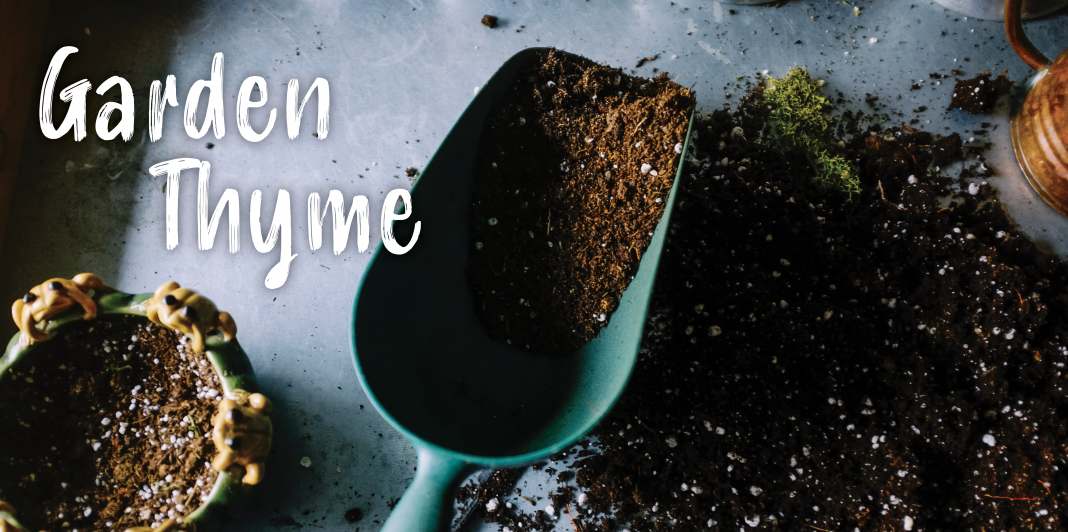Garden Thyme: Surviving the Dog Days of Summer
During the long, oppressively hot Dog Days of summer (July 3 to August 11), it is important to be proactive to protect ourselves from serious illness and our gardens from damage. When working and playing outside, preventing heat-related illnesses can be a challenge. Likewise gardens and plants must receive special attention to survive and thrive. Remember plants are similar to us humans – they can easily succumb to excessive heat and they require water to allow reactions in their cells that provide energy for growth.
For Humans
Heat-related illnesses include Heat Stroke, Heat Exhaustion, Rhabdomyolysis, Heat Syncope, Heat Cramps and Heat Rash. Some can be serious and result in permanent disability or death. For information on symptoms and first aid treatment visit the CDC website https://www.cdc.gov/niosh/topics/heatstress/heatrelillness.html
Staying hydrated is one of the most important things to do to prevent heat-related illness.
Steps to take include
- Hydrate before, during and after being outside.
- Drink enough fluids. Drink 8 oz. (1 cup) every 15 to 20 minutes.
- Drink small amounts at a time. It is more effective than drinking large amounts.
- Do not drink too much water or other fluids (sports drinks, energy drinks, etc.). Limit water to 48 oz. per hour. Too much can cause the concentration of salt in the blood become too low and cause a medical emergency.
- Eat regularly to replace salt lost in sweating.
- Water-Rich Foods that Hydrate. Many fruits and vegetables are water-rich and also contain vital nutrients. Fruits that are more than 90% water include (percentages vary)
- Tomatoes, Pineapple, and Blueberries – 95%
- Cantaloupe, Watermelon and Strawberries – 92%
- Grapefruit – 91%
- Vegetables that are more than 90% water include (percentages vary)
- Lettuce and Cucumber – 96%
- Zucchini, Radish, Bok Choy and Celery – 95%
- Green Bell Peppers – 94%
- Cabbage, Asparagus, Eggplant and Okra 93%
- Cauliflower, Eggplant, Mushrooms, Red cabbage, and Spinach – 92%
- Broccoli – 91%
For Plants During Extreme Heat: Surviving excessive heat for plants depends in large part to having adequate water.
When to Water:
- Water about 2 – 3 times a week. Plants need 1 inch of water per day.
- Water when the plants need water. How do you know when to water?
- Poke your finger into the soil. If it is wet an inch or two down, it does not need to be watered. If it is dry, give it a good, soaking watering.
- Look for wilting plants. Some big leaf plants such as squash, cucumbers and melons may wilt first.
- If they recover in the evening, they do not need to be watered.
- If they are wilted in the morning, they may be overwatered.
- Be consistent with watering. Don’t go from wet to dry over and over again. It can cause blossom end rot and cracks in fruit such as tomatoes.
- The best time to water plants is in the early morning. However, you can’t water in the morning, water in the evening.
- Container plants may need to be watered more often. Some may require two times per day.
- For lawns, water every day.
How to Water:
- Water at the base of the plants.
- Try not to get water on the leaves.
- Water deeply. Watering only the top of the ground will cause shallow roots. Water slowly and long enough so the water soaks into the ground.
- Avoid wetting leaves, if possible. If your watering system gets water on the leaves, water in the early morning so the leaves have time to dry. This will help prevent diseases.
Helpful Hints
- Mulch. Use 2 – 3 inches of organic materials – straw, pine needles, chopped leaves, ground bark, shredded paper or cardboard. This will help prevent evaporation and shield the soil from the hot sun.
- Weed. Weeds compete with plants for water.
- Incorporate organic matter such as compost or peat moss into the soil. It will absorb and help retain water.
- Use a drip irrigation system and automatic timers to allow water to slowly drip to prevent runoff and allow the water to be absorbed into the soil.
The “Dog Days” of summer, from July 3 to August 11, are usually the hottest and most miserable days of the year. People have believed they are called “Dog Days” because they are not fit for a dog or because they are so hot that dogs just laze around or because this is the time when dogs can go crazy.
In reality, the term refers to the Dog Star, Sirius, which represents one of Orion’s hunting dogs, and is the brightest star visible from the Earth. Sirius is in the constellation Canis Major or Greater Dog. It rises and sets with the Sun in the summer; on July 23rd it rises beside the Sun. Because it was so bright, the ancient Romans thought Sirius gave off heat which combined with the Sun’s heat to make the days surrounding this day the hottest of the year. They called the period 20 days before and after July 23 “dies canulares” or “Dog Days”.
Actually, Sirius has nothing to do with this period of excessive heat. It is caused by the tilt of the Earth. In the Northern Hemisphere, in the summer, the tilt of the Earth causes the Sun’s rays to be at a more direct angle for a longer time, making the days longer and hotter.















